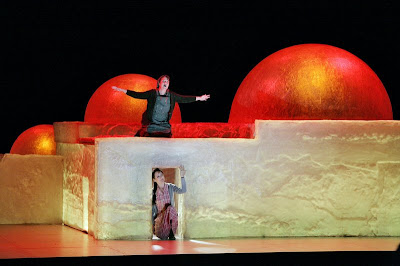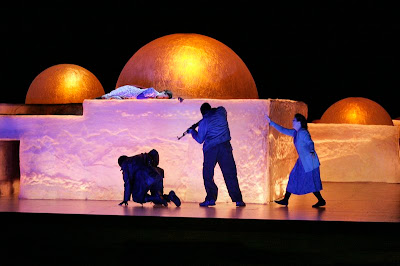For more background information on this opera, see my preview article on Adriana Mater.

Monica Groop (Adriana, below) and Pia Freund (Refka, above) in Adriana Mater, directed by Peter Sellars, Santa Fe Opera, 2008 (photo © Ken Howard) |
On Saturday night, the Santa Fe Opera extended its distinguished history of presenting new operas to American audiences, with the American premiere of Kaija Saariaho's second opera, Adriana Mater. Earlier that morning, at a symposium on the opera, the composer, librettist Amin Maalouf, and director Peter Sellars spoke about the opera and its third production (after the world premiere in Paris and a production at the Finnish National Opera this spring). The Santa Fe theater required some adjustments, to George Tsypin's luminous sets, to the casting, and especially to the orchestration, which had to be reduced in numbers of strings and other instruments. Even so, the opera lost little of its emotional punch, unfolding in a steady, purling flow, tidal, glacial, pulsatingly quiescent. There will be more to say about the work itself after a second hearing tonight [see my Final Thoughts on the 2008 Season].
The libretto by Amin Maalouf is set in a village before and after a devastating war. No nationality or location is specified, and the enemy force that threatens is identified only as les autres, the others. The character names and other minor details make the Serbian-Bosnian conflict the likely background (something confirmed by Maalouf), but the idea is that the story could easily be imagined in any number of wartorn areas. (Maalouf, raised in French Catholic schools in his native Lebanon, has lived in France since the 1970s and writes in French: so the themes of homelessness and civil strife have a background in Lebanon, too.) George Tsypin's sets, made of sculpted resin, glow with light like burning embers or reflect it like dull metal or stone, recalling the domes of mosques or Eastern Orthodox churches. In the second act, most of the village walls have been reduced to rubble, the only real reference to the warfare that has occurred in the time elapsed between the rape of the central character, Adriana, and the birth of her son, Yonas.

Monica Groop (Adriana) and Pia Freund (Refka) in Adriana Mater, sets by George Tsypin, Santa Fe Opera, 2008 (photo © Ken Howard) |
War and violence are told only through the interactions of four characters: a soldier, Tsargo, rapes a woman, Adriana, who confides in her sister, Refka, and gives birth to the soldier's son, Yonas. The son discovers that his father is not a war hero, as his mother told him when he was growing up, but a rapist and murderer. When the rapist returns to the village at the end of his life, the son confronts him and threatens to kill him. (The question of paternal identity is also at the center of the recent film set in Sarajevo, Grbavica: The Land of My Dreams.) A faceless chorus comments from the pit, amplified at Santa Fe, as are all the principal singers, mostly repeating words or phrases sung by the characters, as well as singing on neutral syllables and occasionally introducing their own words. At the symposium, Saariaho said definitively about the chorus, "They are not persons. They color the orchestra, continuing some of the lines." As Peter Sellars sees them, she added, "they are like spirits in the village."

Monica Groop (Adriana), Matthew Best (Tsargo), Pia Freund (Refka), and Joseph Kaiser (Yonas) in Adriana Mater, Santa Fe Opera, 2008 (photo © Ken Howard) |
As Adriana, mezzo-soprano Monica Groop was eloquent, still, and richly voiced, although many of the lowest parts of the role trailed off into shouted speech. As Adriana's sister, Refka, soprano Pia Freund, struggling with a cold, was less beautiful in sound, but just as dramatically convincing. Both women, who are Finnish, sounded less than idiomatic in French, although the sense of alienation from language is not necessarily inappropriate, and both were occasionally covered in louder orchestral passages, despite the amplification. Matthew Best's Tsargo had a growly menace, both pathetic and threatening, although in the first scene he did not appear as a young man (as Peter Sellars put it at the symposium and the libretto indicates). The young Canadian tenor, Joseph Kaiser, was also suffering from a cold but recovered on opening night to give a dramatic and heroic rendition of the high-lying part of Yonas, Adriana's son. Their embrace of reconciliation at the end of the opera, beginning with just putting their heads on the other's shoulder, was a striking, emblematic moment.

Monica Groop (Adriana) and Joseph Kaiser (Yonas) in Adriana Mater, Santa Fe Opera, 2008 (photo © Ken Howard) |
It was difficult not to regret that Esa-Pekka Salonen, who conducted the opera's premiere, had been replaced by Ernest Martinez Izquierdo at the podium, first in Finland and now at Santa Fe. In his entertaining comments at the symposium, Peter Sellars made a point of stating that Izquierdo loves the score of Adriana and conducts with that love, adding wryly that love is not a word associated with what most conductors do (unless it has "self-" in front of it). Izquierdo certainly knows the score well and shaped it with delicacy and scope, keeping the extremely complicated structures aligned, allowing masses of sound to blossom and evaporate. The pace of the opera is slow and deliberate, mixing dream and reality in an almost indistinguishable way. More than once at the symposium, Peter Sellars used the image of a Byzantine altarpiece to describe how the libretto and music worked, with the characters removed from time and space, against a golden background.
Other Reviews:
Craig Smith, ‘Adriana’ has plenty of depth, heft (Santa Fe New Mexican, July 28)
Anthony Tommasini, Compassion, Not Revenge, After a Rape in a War Zone (New York Times, August 1)
Scott Cantrell, Santa Fe Opera premieres arresting war story, 'Adriana Mater' (Dallas Morning News, August 1)
Anne Midgette, Promising 'Adriana' Could Use a Drama Lesson (Washington Post, August 4)
George Loomis, Adriana Mater, Santa Fe Opera (Financial Times, August 4) |
Saariaho's compositional inclinations have included electronics and spectralism, the unfolding of dissonances around the central organizing principle of the overtone series. Some themes stood out over several hearings, especially a downward microtonal glissando, perhaps a sighing motif, that is repeated throughout the score. Downward half-steps, set sharply on the beat, also pervade the music, ultimately associated with the repeated singing of "J'aurais dû" (I should have), as the four characters all express regrets in the final scene. The rocking semitone pulses through the score until the final tableau, as mother and son embrace, and then resolves. Saariaho's sound is distinctive, although she turns to more or less standard atonal clusters, amassed in huge waves, to set the rape scene. Much more memorable are the softer washes of sound, especially as larger orchestral tutti passages vanish, to reveal the ping of a triangle, the rumble of contrabassoon or low brass, or the stray raindrops of celesta or the extensive battery of percussion.
For all of Saariaho's association with IRCAM and the French spectralists, it is the orchestral music of Sibelius that seems the most important influence. At more than a few points, as magisterial brass spiked their heads through the texture, similar moments in Sibelius's symphonies came to mind. The comparison puts me in mind of what Saariaho said about Adriana during the symposium, that it was the dream sequences she most relished, as they allowed her to turn her ear from the horrors of the story's oppressive reality. Noting that she has a complex dream life herself, Saariaho said that no matter how long she has lived in Paris, her dreams are always set in Finland.
Kaija Saariaho's Adriana Mater will be repeated at Santa Fe Opera on July 30 (tonight) and August 8 and 12.

























































1 comment:
Thank you for this thoughtful review of an important American operatic premiere.
Post a Comment